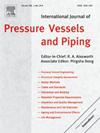Microstructure evolution of NiAl alloy seamless tubes formed by an integrated forming process using laminated Ni/Al foil continuous winding
IF 3
2区 工程技术
Q2 ENGINEERING, MECHANICAL
International Journal of Pressure Vessels and Piping
Pub Date : 2025-05-09
DOI:10.1016/j.ijpvp.2025.105554
引用次数: 0
Abstract
In order to overcome the difficulties in forming NiAl alloy seamless tubes by conventional hot forming, a novel integrated process of internal high-pressure connection and reaction synthesis was proposed using laminated Ni/Al foil continuous winding. The microstructure evolution route and voids inheritance mechanism between element foils were investigated by scanning electron microscopy (SEM) and electron backscatter diffraction (EBSD). The forming defects of the integrated process were analyzed using SEM and energy-dispersive X-ray spectrometer (EDS) microstructure analysis methods. Uniaxial tensile tests and microstructure characterization were conducted to observe the impacts of lay-up patterns and initial foils on the thin-walled components in order to determine the performance control strategy. It was shown that the NiAl alloy seamless tubes were successfully fabricated by the integrated process, and achieved the desired cylindrical shape with a diameter of 39 mm, wall thickness of 1.3 mm, and length of 155 mm. The microstructure of the NiAl alloy tube mainly consisted of Ni and Ni2Al3 layers after the first stage of reaction synthesis, with a thickness of 16.07 μm and 126.07 μm, respectively. Voids were observed in the middle of the Ni2Al3 layers located parallel to the rolling plane, with a thickness of approximately 8.15 μm. At the end of the first and second stages of reaction synthesis, the detached Al or Ni independent bodies were completely wrapped by the NiAl3 or Ni3Al layers, respectively. The reduced pressure led to an insufficient reduction of Kirkendall voids at the NiAl3/Al and Ni/Ni3Al interfaces. Consequently, voids were formed in the original position of the Al and Ni layers, and then inherited into the final NiAl alloy component. Furthermore, the Ni/Ni2Al3/Ni multilayered structure fabricated under the first stage of reaction synthesis performed superplastic behavior at 900 °C. Ni phase in the deformed Ni/Ni2Al3/Ni multilayered structures was completely dissolved in the Ni2Al3 matrix after reaction diffusion treatment at 1200 °C. This provided potential opportunities of forming complex shapes for NiAl alloy tubular part. The simultaneous reduction of the initial thicknesses of Ni and Al foils decreased the average grain size in the coarse-grained layers (CGLs) and fine-grained layers (FGLs). The adoption of an Al foil with a double-layer structure of half the initial thickness improved the ultimate tensile strength (UTS).
复合Ni/Al箔连续缠绕一体化成形NiAl合金无缝管的组织演变
为了克服常规热成形NiAl合金无缝管的困难,提出了一种采用层压Ni/Al箔连续缠绕的内高压连接与反应合成一体化工艺。利用扫描电镜(SEM)和电子背散射衍射(EBSD)研究了元件箔之间的微观结构演变路线和空洞遗传机制。采用扫描电子显微镜(SEM)和能谱仪(EDS)的微观结构分析方法对一体化工艺的成形缺陷进行了分析。通过单轴拉伸试验和微观组织表征,观察铺层方式和初始箔对薄壁件性能的影响,确定性能控制策略。结果表明,采用一体化工艺成功制备了NiAl合金无缝管,其直径为39 mm,壁厚为1.3 mm,长为155 mm,达到了理想的圆柱形。第一阶段反应合成后,NiAl合金管的显微组织主要由Ni层和Ni2Al3层组成,厚度分别为16.07 μm和126.07 μm。在与轧制平面平行的Ni2Al3层中间出现了空洞,空洞厚度约为8.15 μm。在第一阶段和第二阶段的反应合成结束时,分离的Al或Ni独立体分别被NiAl3或Ni3Al层完全包裹。压力的降低导致NiAl3/Al和Ni/Ni3Al界面上的Kirkendall空洞减少不足。因此,在Al和Ni层的原始位置形成空洞,然后继承到最终的NiAl合金成分中。此外,在第一阶段反应合成下制备的Ni/Ni2Al3/Ni多层结构在900℃下表现出超塑性行为。经1200℃反应扩散处理后,变形Ni/Ni2Al3/Ni多层结构中的Ni相完全溶解在Ni2Al3基体中。这为NiAl合金管状零件的复杂形状的成形提供了潜在的机会。同时减小Ni和Al箔的初始厚度,减小了粗晶层和细晶层的平均晶粒尺寸。采用初始厚度一半的双层结构铝箔,提高了极限拉伸强度(UTS)。
本文章由计算机程序翻译,如有差异,请以英文原文为准。
求助全文
约1分钟内获得全文
求助全文
来源期刊
CiteScore
5.30
自引率
13.30%
发文量
208
审稿时长
17 months
期刊介绍:
Pressure vessel engineering technology is of importance in many branches of industry. This journal publishes the latest research results and related information on all its associated aspects, with particular emphasis on the structural integrity assessment, maintenance and life extension of pressurised process engineering plants.
The anticipated coverage of the International Journal of Pressure Vessels and Piping ranges from simple mass-produced pressure vessels to large custom-built vessels and tanks. Pressure vessels technology is a developing field, and contributions on the following topics will therefore be welcome:
• Pressure vessel engineering
• Structural integrity assessment
• Design methods
• Codes and standards
• Fabrication and welding
• Materials properties requirements
• Inspection and quality management
• Maintenance and life extension
• Ageing and environmental effects
• Life management
Of particular importance are papers covering aspects of significant practical application which could lead to major improvements in economy, reliability and useful life. While most accepted papers represent the results of original applied research, critical reviews of topical interest by world-leading experts will also appear from time to time.
International Journal of Pressure Vessels and Piping is indispensable reading for engineering professionals involved in the energy, petrochemicals, process plant, transport, aerospace and related industries; for manufacturers of pressure vessels and ancillary equipment; and for academics pursuing research in these areas.

 求助内容:
求助内容: 应助结果提醒方式:
应助结果提醒方式:


